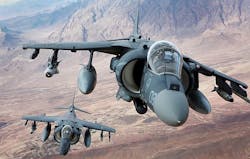30 years later, Marine Corps Boeing AV-8B jump jet still being upgraded as front-line attack jet
The vertical and short takeoff and landing (VSTOL) aircraft after three decades of service still remains a unique military plane. It can take off straight up like a helicopter, can operate from unimproved short takeoff strips, can take of from amphibious assault ships, can take off conventionally from long runways, and despite its age has cutting-edge avionics.
It's not a sleek-looking aircraft; and can't fly at supersonic speeds; it's a mud fighter, and the plane looks it. The AV-8B appears stubby and awkward, and if you've ever been close-by when the thing takes off vertically, you know it's really LOUD.
Still, the plane has been the go-to aircraft for six Marine Corps attack squadrons and one training squadron that provides advanced instruction in the Harrier II. It can provide close air support to Marine infantry on the ground quickly, and can carry larger weapons payloads than Marine attack helicopters.
For Marines pinned down and in trouble on the battlefield, there are few sights and sounds more welcome than Harrier II jets as they start pounding enemy positions. For the Marines it can be every bit as much the infantryman's friend as the A-10 Warthog is for the Army.
As far as the AV-8B's avionics are concerned, the aircraft began its service roughly at the dawn of integrated military avionics architectures built around the MIL-STD-1553 digital databus.
Before the Harrier IIs and their contemporaries like the F/A-18 Hornet fighter-bomber, military aircraft typically had federated avionics architectures that were wired point-to-point. The first generation of 1553-equipped planes ushered in the era of networked avionics.
Suffice it to say we've come a long way since then. Nevertheless, after many series of electronics upgrades, the Marine Corps AV-8B Harrier II still has one of the most advanced and sophisticated avionics architectures in the air.
Related: Navy to install FACE-based avionics computer upgrade in Marine Corps AV-8B attack jet fleet
Not long after its initial deployments in 1985, the plane's designer McDonnell Douglas (now Boeing) started developing a night fighter version. Over the years it's received radar upgrades, engine upgrades, larger wings, and new missiles and bombs.
story continues below
In the late 1990s the Navy and Marine Corps worked together to overhaul the AV-8B's avionics as part of the Open Systems Core Avionics Requirement (OSCAR) program to replace the plane's AN/AYK-14 Navy standard airborne computer with new avionics computers and software based on the PowerPC microprocessor.
The plane went out of production in 2003, but the upgrades just kept coming.
Two years ago the Navy contracted with General Dynamics Advanced Information Systems in Minneapolis to upgrade the Harrier II's Mission Systems Computer (MSC) -- an open-systems architecture based on 6U VME embedded computing technology.
Related: Navy considers upgrading AV-8B jump jet with small-form-factor Link 16 MIDS terminals
This 2013 computer upgrade saw General Dynamics engineers install industry-standard interfaces in the AV-8B's mission computer that meet guidelines of the Future Airborne Capability Environment (FACE) standards program.
Just last December Navy avionics experts authorized a study to determine the feasibility of installing small-form-factor military Link 16 tactical data exchange networking capability on the AV-8B -- a particular challenge given the plane 1980s-vintage design.
Finally, this month Navy officials announced a pending contract to General Dynamics to equip the AV-8B's computers with Ethernet networking capability to handle increased sensor and signal processing bandwidth.
Over its 30-year life span, the AV-8B has been through the wars. It saw extensive action during the first Persian Gulf War in 1990 and 1991, and also saw action during the second Gulf War in 2003. The planes also took part in operations in Yugoslavia in 1999, and in Operation Enduring Freedom in Afghanistan starting in 2001.
Related: Marines experience their worst air disaster in nearly half a century
Three years ago AV-8Bs were involved in what was perhaps the worst Marine Corps air disaster in nearly half a century during a terrorist attack on the airfield at Camp Bastion in Southern Afghanistan, when six AV-8Bs belonging to Marine Corps Attack Squadron 211 (VMA-211) were destroyed, two reportedly were damaged beyond repair, and two Marines were killed.
It's been a long road over the past three decades, but continuing work has kept the AV-8B Harrier II on the forefront of technology. The effort hasn't been wasted, either, because Navy leaders say they expect to keep the Harrier II in operation at least until 2020.
When the last AV-8Bs are retired in another decade or more, Navy leaders expect to replace them with vertical and short takeoff versions of the F-35 joint strike fighter.

